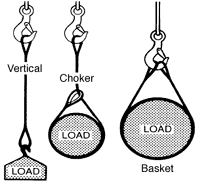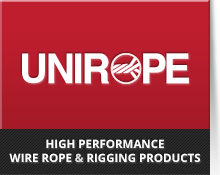Use of Synthetic Slings
Basic Factors concerning the use of Synthetic Slings
- RATED CAPACITY (Rated Load; WLL) of a sling is based upon the Nominal Breaking Strength of the material used in the sling, AND FACTORS which affect the overall strength of a sling. These factors include ATTACHMENT or FABRICATION EFFICIENCY, the number of plys in a web sling, type of hitch (see below), LOAD SHAPE AROUND WHICH THE BODY OF THE SLING IS POSITIONED, and the shape of the hardware which the sling is rigged with to the crane or lifting device.
- RATED CAPACITY of a sling is different for each of the three basic methods of rigging (see below). These rated capacities are listed in this catalogue. The RATED CAPACITIES apply to slings made by UNIROPE ONLY and are indicated on capacity tags.
- NEVER “SHOCK LOAD” a sling. There is no practical way to estimate the actual force applied by shock loading. The rated capacity of a sling can easily be exceeded by a sudden application of force, and damage can occur to the sling. The sudden release of a load can also damage a sling.
- The BODY of a sling MUST be protected with corner protectors, blocking or padding against damage by sharp edges or corners of a load being lifted. Sharp bends that distort or cut the sling body will result in sling failure.
- ANY ANGLE other than vertical at which the sling is rigged, increases the loading (tension) on the sling.
- A sling should be given a VISUAL INSPECTION BEFORE EACH LIFT OR USAGE to determine if it is capable of safely making the intended lift.
- An inspection should include such things as:
- Acid or Caustic Burns
- Melting or charring of any part of the sling
- Holes, tears, cuts, or snags
- Broken or worn stitching in load bearing splices
- Abrasive Wear
- Knots in any part of the sling
- Damage to end fittings
- Other visible damage that causes doubt as to the strength of the sling
- Whenever a sling is found to be deficient, the eyes must be cut, or other end attachments or fittings removed to prevent further use, and the sling body discarded.
- Synthetic Slings should be stored in a cool, dry, and dark place. Slings should also be kept free of dirt and foreign material. Mild soap and water can be used to clean slings.
Every Lift uses 1 of 3 Basic Hitches

VERTICAL, or straight, attachment is simply using a sling to connect a lifting hook or other device to a load. Full rated load of the sling may be used, but never exceeded. A tagline should be used on such a lift to prevent rotation which can damage the sling.
CHOKER hitches reduce lifting capacity of a sling, since this method of rigging affects the ability of the sling to adjust during the lift, places angular loading on the body of the sling, and creates a small diameter bend in the sling at the choke point.
BASKET hitches distribute the load equally between the two legs of a sling, within limitations imposed by the angles at which legs are rigged to the load.



